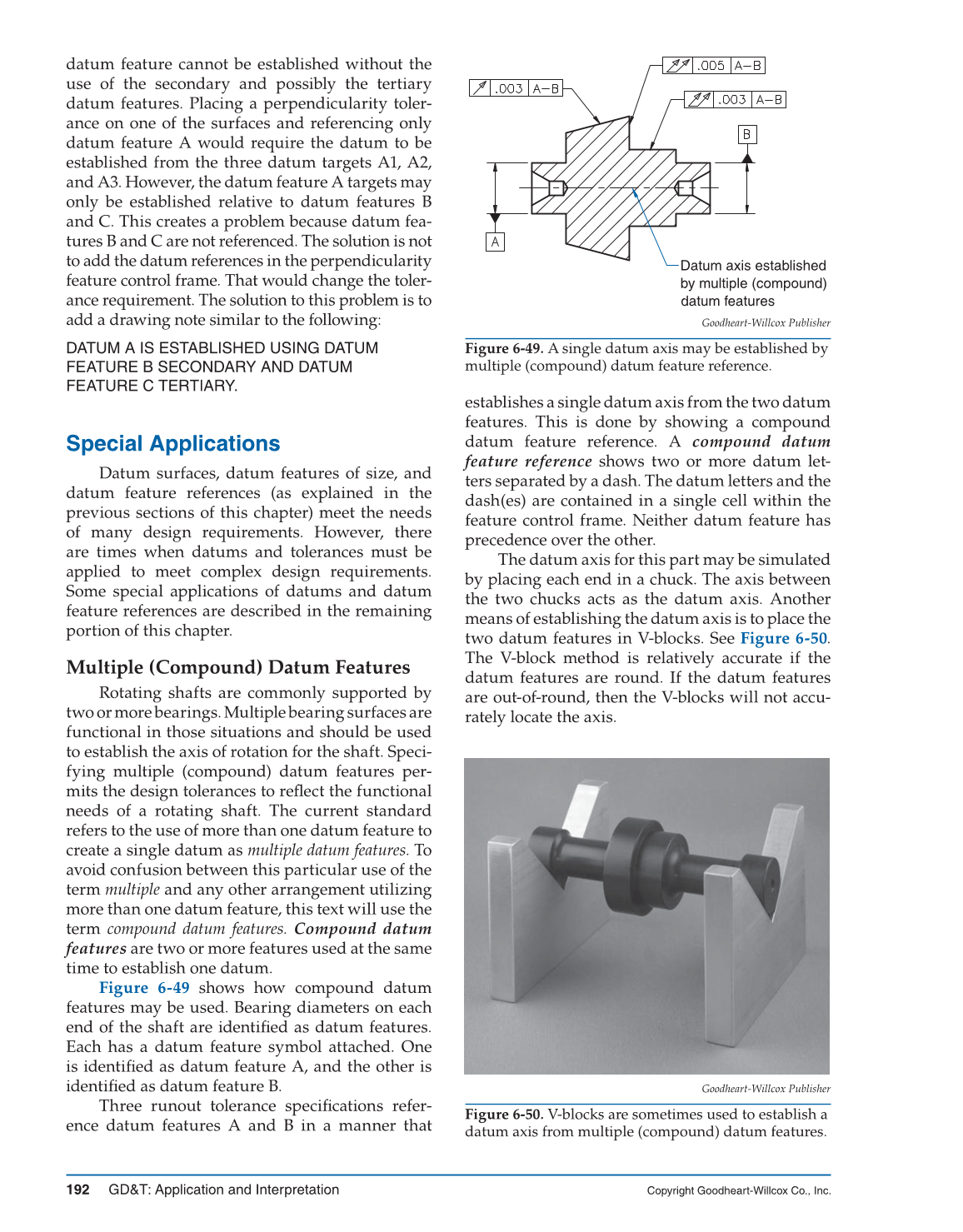192 GD&T: Application and Interpretation
Copyright Goodheart-Willcox Co., Inc.
datum feature cannot be established without the
use of the secondary and possibly the tertiary
datum features. Placing a perpendicularity toler-
ance on one of the surfaces and referencing only
datum feature A would require the datum to be
established from the three datum targets A1, A2,
and A3. However, the datum feature A targets may
only be established relative to datum features B
and C. This creates a problem because datum fea-
tures B and C are not referenced. The solution is not
to add the datum references in the perpendicularity
feature control frame. That would change the toler-
ance requirement. The solution to this problem is to
add a drawing note similar to the following:
DATUM A IS ESTABLISHED USING DATUM
FEATURE B SECONDARY AND DATUM
FEATURE C TERTIARY.
Special Applications
Datum surfaces, datum features of size, and
datum feature references (as explained in the
previous sections of this chapter) meet the needs
of many design requirements. However, there
are times when datums and tolerances must be
applied to meet complex design requirements.
Some special applications of datums and datum
feature references are described in the remaining
portion of this chapter.
Multiple (Compound) Datum Features
Rotating shafts are commonly supported by
two or more bearings. Multiple bearing surfaces are
functional in those situations and should be used
to establish the axis of rotation for the shaft. Speci-
fying multiple (compound) datum features per-
mits the design tolerances to refl ect the functional
needs of a rotating shaft. The current standard
refers to the use of more than one datum feature to
create a single datum as multiple datum features. To
avoid confusion between this particular use of the
term multiple and any other arrangement utilizing
more than one datum feature, this text will use the
term compound datum features. Compound datum
features are two or more features used at the same
time to establish one datum.
Figure 6-49 shows how compound datum
features may be used. Bearing diameters on each
end of the shaft are identifi ed as datum features.
Each has a datum feature symbol attached. One
is identifi ed as datum feature A, and the other is
identifi ed as datum feature B.
Three runout tolerance specifi cations refer-
ence datum features A and B in a manner that
establishes a single datum axis from the two datum
features. This is done by showing a compound
datum feature reference. A compound datum
feature reference shows two or more datum let-
ters separated by a dash. The datum letters and the
dash(es) are contained in a single cell within the
feature control frame. Neither datum feature has
precedence over the other.
The datum axis for this part may be simulated
by placing each end in a chuck. The axis between
the two chucks acts as the datum axis. Another
means of establishing the datum axis is to place the
two datum features in V-blocks. See Figure 6-50.
The V-block method is relatively accurate if the
datum features are round. If the datum features
are out-of-round, then the V-blocks will not accu-
rately locate the axis.
datum features
by multiple (compound)
Datum axis established
Goodheart-Willcox Publisher
Figure 6-49. A single datum axis may be established by
multiple (compound) datum feature reference.
Goodheart-Willcox Publisher
Figure 6-50. V-blocks are sometimes used to establish a
datum axis from multiple (compound) datum features.
